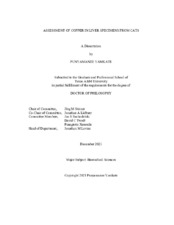| dc.description.abstract | Copper is an essential trace element that can produce reactive oxygen species (ROS). Excess ROS promote oxidative stress, which can lead to hepatic injury. Copper-associated hepatopathy is well-studied in humans and dogs. In contrast, there is limited information describing hepatic copper accumulation in cats. Our studies assessed copper in liver specimens from cats using qualitative (rhodanine staining) and quantitative assessment. We separated liver fractions and evaluated the intracellular distribution of copper in specimens from cats with copper concentrations below and above the upper limit of the reference interval (ULRI: 180 μg/g dry weight liver). To assess oxidative stress, we evaluated the immunohistochemical expression of 4-hydroxynonenal (4-HNE) and malondialdehyde (MDA) in the same liver specimens. Finally, to assess apoptosis, we evaluated the immunohistochemical expression of active caspase 3 (Casp-3) in the same specimens.
Hepatic copper concentrations above the ULRI were commonly found in cats regardless of histopathological changes of the liver. Liver specimens from Malaysia had higher copper concentrations compared to those from the United States and Greece. A weak correlation between the hepatic copper score and copper concentrations was found. The intracellular distribution of copper was highest in the cytosol, followed by the nuclear, large granule, and microsomal fractions, respectively in specimens with either copper below or above the ULRI. The immunohistochemical expression of 4-HNE, MDA, and Casp-3 was not significantly different in specimens from cats with liver diseases compared to those without significant hepatic changes. There was no significant correlation between the hepatic copper score or copper concentrations and these markers.
Our findings suggested that the reference interval for hepatic copper in cats needs to be re-evaluated and should be established based on geographical location. Factors, such as environmental contamination, diet, and intracellular localization of hepatic copper, that may affect copper concentrations and copper staining should be investigated. Our findings of immunohistochemical expression of 4-HNE, MDA, and Casp-3 did not support the utility of these markers in cats with liver diseases. Further studies to assess other potential biomarkers of oxidative stress or apoptosis are warranted. Future studies are needed to better define the importance of hepatic copper in cats. | |


